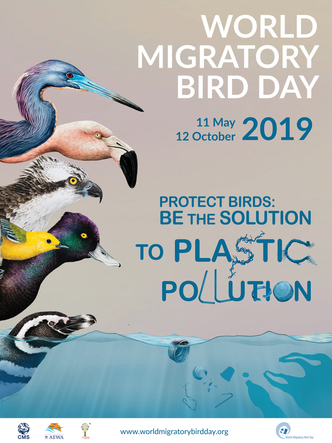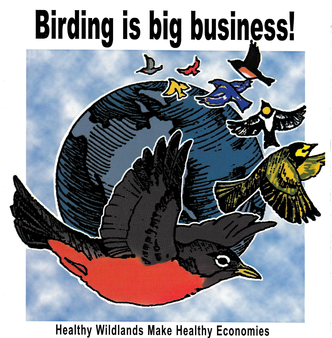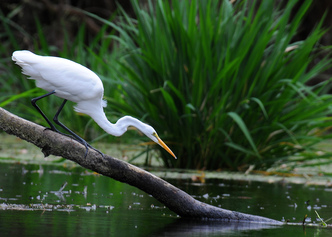
World Migratory Bird Day is coming up on Saturday, May 11! Since 2006, groups around the world have recognized the importance of migratory birds on the second Saturday in May by hosting field trips, educational events and service projects.
This year, World Migratory Bird Day is focused on plastic pollution, an issue that has a significant impact on many bird species. Over 300 million tons of plastic are produced each year, and an estimated 8 million tons enter the ocean each year – that’s the equivalent of dumping a garbage truck of plastic into the ocean every minute. Scientists estimate that by 2050, 99% of seabirds will be ingesting plastic waste, which can cause physical internal damage or lead to starvation.
What can you do to help? Recycling plastic is certainly preferable to sending it to a landfill, but it isn’t a permanent solution – only 10% of the plastic recycled since the 1950s has been recycled more than once, meaning that recycling only delays disposal. Our best bet is to avoid single-use plastics as much as possible and to spread the word! You also can join or organize cleanup events in your community – the birds will thank you!
Click here to learn more about World Migratory Bird Day and to find events taking place near you!

In last month’s newsletter, we talked about the many benefits of birding locally – you can reduce your carbon footprint, contribute to citizen science by exploring under-birded areas and develop a deeper appreciation of the birds in your neighborhood! This month, though, we want to tell you about the many benefits that traveling birders provide.
Did you know that wildlife viewing is ranked as the second most popular type of outdoor recreation in Florida, and is more popular than fishing, biking, or golf? With our incredible diversity of wildlife, it is not surprising that we attract over 8 billion wildlife tourists each year - more than any other state in the nation! According to the most recent comprehensive study in 2011, our impressive ecotourism sector supports over 40,000 jobs. To put this in perspective, that is more jobs than the entire statewide air travel industry. Wildlife viewing also generates nearly $3 billion a year – more than double the revenue generated by the orange industry!
Those of us who love wildlife aren’t usually in it for the money, but the economic benefits of a strong ecotourism industry can translate into strong incentives for conservation action! If you want to help us hammer the point across, let local businesses know why you are in the area when you go birding: wear your binoculars; tell them where you are going; and tell them what you’ve seen. The more ways we can show that our wildlife and wild spaces are valuable, the better chance they have to remain protected for years to come.
 Greg the Great Egret on the hunt. Photo by Larry Korhnak
Have you ever heard someone refer to a Mourning Dove as a “modo”? Birders and scientists alike will sometimes use standardized abbreviations called alpha codes as shorthand for a bird’s full name, which can be very useful when jotting down notes in the field.
For birds with a single word in their name, the code is just the first four letters of the name. For example, “Mallard” would be abbreviated as MALL. If there are two words in the name, the first two letters of each name are used. A Common Merganser would be shortened to COME. Beyond that, the rules get a little bit more complicated, but with practice, alpha codes can be a great tool for note taking.
Most of these codes work better when written down than spoken aloud – the Black-crowned Night-heron’s BCNH doesn’t exactly roll of the tongue – but some of them are very fun to say! Here are a few of our favorites.
EAGR – I am eager indeed to travel west and see an Eared Grebe someday.
PROW – This one is especially fun if a curious Prothonotary Warbler happens to land on the front of your boat.
BUHU – I might weep with joy if I get to see the tiny Bumblebee Hummingbird someday!
KILL – I know they have red-rimmed eyes, but I don’t think that Killdeer are scary enough to live up to this one…
GREG – It’s always nice to be on a first name basis with a Great Egret.
Check out the full list of alpha codes at the Institute for Bird Populations site if you want to give this shortcut a try!
 Live oaks arch over an unpaved road on a sunny spring day at Andrews Wildlife Management Area. Photo by Liz Schold, FWC.
Andrews Wildlife Management Area in Levy County is a 3,582-acre property adjacent to the beautiful Suwannee River. The management area includes a diverse array of habitats including floodplain swamp and hardwood hammock. More than 10 miles of trails and unpaved roads give you access on foot or bicycle to the interior of this site, where you can find former state champion trees within mature hardwood forest. Be sure to walk along the interpretive boardwalk over a floodplain swamp, looking and listening for Prothonotary Warblers and Acadian Flycatchers, and to spend some time quietly watching from the wildlife viewing blind, where you may spot a flock of Wild Turkeys. You may also be able to hear Brazilian free-tailed bats chittering inside of the on-site bat houses!
You can put your boat in at the ramp and explore the tree-lined Suwannee River, keeping your eyes peeled for wading birds on the banks and for Ospreys soaring overhead. For adventurous explorers, both Manatee Springs State Park and Fanning Springs State Park are within paddling distance!
Before you go, be sure to print a copy of the trail map or order a copy of the Andrews WMA Recreation Guide. Don’t forget to bring plenty of water and snacks!
Please note that this site is open to seasonal hunting, and is closed to other uses during some weekend hunts in October through April; please check online or call ahead for more information.
Address: 9550 NW 160th St., Fanning Springs, 32693
Phone: 386-758-0525
Hours: Daily, sunrise to sunset
May 4 – Hernando Audubon trip to view nesting Purple Martins (Brooksville)
May 4 – Silver Springs Forest Conservation Area Walk (Silver Springs)
May 6 – Clearwater Audubon Society Meeting; Red-cockaded Woodpecker talk (Clearwater)
May 11 – STA 5/6 Driving Bird Tour (Clewiston)
May 14 – Anastasia State Park Guided Bird Walk (Saint Augustine)
May 16 – Dunlawton Bridge Bird Walk (Port Orange)
May 17–19 – Wild Amelia Nature Festival (Fernandina Beach)
May 26 – Anastasia State Park Guided Bird Walk (St. Augustine)
Check out the events page of our website for more events across the state!
Do you know about any other bird or wildlife-related events going on in Florida? Help spread the word by letting us know! Send in the times, dates, locations and contacts to WildlifeViewing@MyFWC.com for posting on the Great Florida Birding and Wildlife Trail website.
Events must be related to birds or other wildlife and must be open to the public. Examples include interpretive programming, summer camps and family programs.
|